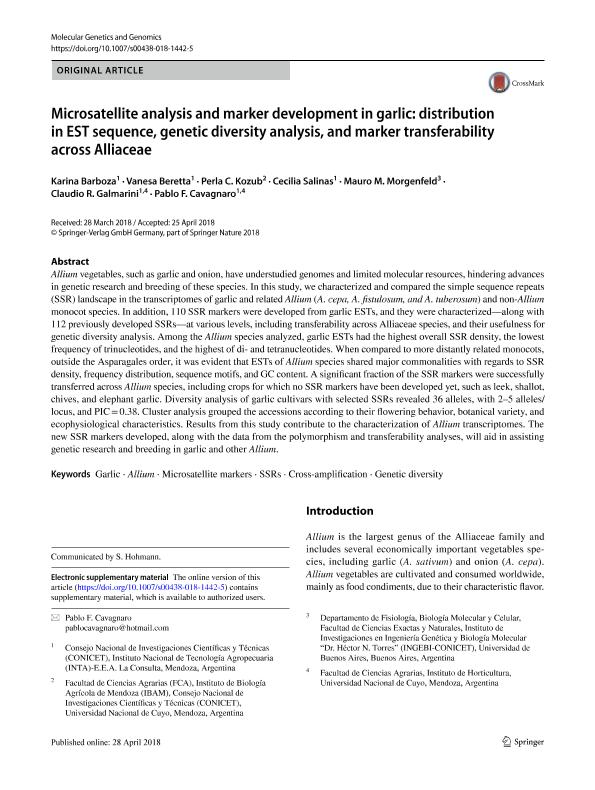Mostrar el registro sencillo del ítem
dc.contributor.author
Barboza Rojas, Karina

dc.contributor.author
Beretta, Hebe Vanesa

dc.contributor.author
Kozub, Perla Carolina

dc.contributor.author
Salinas Palmieri, María Cecilia

dc.contributor.author
Morgenfeld, Mauro Miguel

dc.contributor.author
Galmarini, Claudio Romulo

dc.contributor.author
Cavagnaro, Pablo Federico

dc.date.available
2019-11-14T18:12:23Z
dc.date.issued
2018-10
dc.identifier.citation
Barboza Rojas, Karina; Beretta, Hebe Vanesa; Kozub, Perla Carolina; Salinas Palmieri, María Cecilia; Morgenfeld, Mauro Miguel; et al.; Microsatellite analysis and marker development in garlic: distribution in EST sequence, genetic diversity analysis, and marker transferability across Alliaceae; Springer Heidelberg; Molecular Genetics And Genomics; 293; 5; 10-2018; 1091-1106
dc.identifier.issn
1617-4615
dc.identifier.uri
http://hdl.handle.net/11336/88904
dc.description.abstract
Allium vegetables, such as garlic and onion, have understudied genomes and limited molecular resources, hindering advances in genetic research and breeding of these species. In this study, we characterized and compared the simple sequence repeats (SSR) landscape in the transcriptomes of garlic and related Allium (A. cepa, A. fistulosum, and A. tuberosum) and non-Allium monocot species. In addition, 110 SSR markers were developed from garlic ESTs, and they were characterized—along with 112 previously developed SSRs—at various levels, including transferability across Alliaceae species, and their usefulness for genetic diversity analysis. Among the Allium species analyzed, garlic ESTs had the highest overall SSR density, the lowest frequency of trinucleotides, and the highest of di- and tetranucleotides. When compared to more distantly related monocots, outside the Asparagales order, it was evident that ESTs of Allium species shared major commonalities with regards to SSR density, frequency distribution, sequence motifs, and GC content. A significant fraction of the SSR markers were successfully transferred across Allium species, including crops for which no SSR markers have been developed yet, such as leek, shallot, chives, and elephant garlic. Diversity analysis of garlic cultivars with selected SSRs revealed 36 alleles, with 2–5 alleles/locus, and PIC = 0.38. Cluster analysis grouped the accessions according to their flowering behavior, botanical variety, and ecophysiological characteristics. Results from this study contribute to the characterization of Allium transcriptomes. The new SSR markers developed, along with the data from the polymorphism and transferability analyses, will aid in assisting genetic research and breeding in garlic and other Allium.
dc.format
application/pdf
dc.language.iso
eng
dc.publisher
Springer Heidelberg

dc.rights
info:eu-repo/semantics/openAccess
dc.rights.uri
https://creativecommons.org/licenses/by-nc-sa/2.5/ar/
dc.subject
ALLIUM
dc.subject
CROSS-AMPLIFICATION
dc.subject
GARLIC
dc.subject
GENETIC DIVERSITY
dc.subject
MICROSATELLITE MARKERS
dc.subject
SSRS
dc.subject.classification
Conservación de la Biodiversidad

dc.subject.classification
Ciencias Biológicas

dc.subject.classification
CIENCIAS NATURALES Y EXACTAS

dc.title
Microsatellite analysis and marker development in garlic: distribution in EST sequence, genetic diversity analysis, and marker transferability across Alliaceae
dc.type
info:eu-repo/semantics/article
dc.type
info:ar-repo/semantics/artículo
dc.type
info:eu-repo/semantics/publishedVersion
dc.date.updated
2019-10-15T14:10:57Z
dc.identifier.eissn
1617-4623
dc.journal.volume
293
dc.journal.number
5
dc.journal.pagination
1091-1106
dc.journal.pais
Alemania

dc.description.fil
Fil: Barboza Rojas, Karina. Instituto Nacional de Tecnología Agropecuaria. Centro Regional Mendoza-San Juan. Estación Experimental Agropecuaria La Consulta; Argentina. Consejo Nacional de Investigaciones Científicas y Técnicas; Argentina
dc.description.fil
Fil: Beretta, Hebe Vanesa. Instituto Nacional de Tecnología Agropecuaria. Centro Regional Mendoza-San Juan. Estación Experimental Agropecuaria La Consulta; Argentina. Consejo Nacional de Investigaciones Científicas y Técnicas; Argentina
dc.description.fil
Fil: Kozub, Perla Carolina. Consejo Nacional de Investigaciones Científicas y Técnicas. Centro Científico Tecnológico Conicet - Mendoza. Instituto de Biología Agrícola de Mendoza. Universidad Nacional de Cuyo. Facultad de Ciencias Agrarias. Instituto de Biología Agrícola de Mendoza; Argentina
dc.description.fil
Fil: Salinas Palmieri, María Cecilia. Instituto Nacional de Tecnología Agropecuaria. Centro Regional Mendoza-San Juan. Estación Experimental Agropecuaria La Consulta; Argentina. Consejo Nacional de Investigaciones Científicas y Técnicas; Argentina
dc.description.fil
Fil: Morgenfeld, Mauro Miguel. Consejo Nacional de Investigaciones Científicas y Técnicas. Instituto de Investigaciones en Ingeniería Genética y Biología Molecular "Dr. Héctor N. Torres"; Argentina
dc.description.fil
Fil: Galmarini, Claudio Romulo. Instituto Nacional de Tecnología Agropecuaria. Centro Regional Mendoza-San Juan. Estación Experimental Agropecuaria La Consulta; Argentina. Consejo Nacional de Investigaciones Científicas y Técnicas; Argentina
dc.description.fil
Fil: Cavagnaro, Pablo Federico. Instituto Nacional de Tecnología Agropecuaria. Centro Regional Mendoza-San Juan. Estación Experimental Agropecuaria La Consulta; Argentina. Universidad Nacional de Cuyo. Facultad de Ciencias Agrarias; Argentina. Consejo Nacional de Investigaciones Científicas y Técnicas; Argentina
dc.journal.title
Molecular Genetics And Genomics

dc.relation.alternativeid
info:eu-repo/semantics/altIdentifier/url/http://link.springer.com/10.1007/s00438-018-1442-5
dc.relation.alternativeid
info:eu-repo/semantics/altIdentifier/doi/https://doi.org/10.1007/s00438-018-1442-5
Archivos asociados
